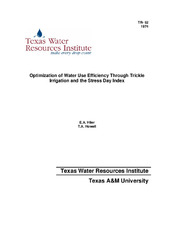| dc.description.abstract | Water deficits reduce plant growth and subsequently, crop yields. Man has relied upon irrigation to overcome these crop water deficiencies. But since the present supplies of water are limited, more efficient irrigation application methods must be developed and utilized effectively. High frequency irrigation has been shown to be an efficient means for minimizing crop water deficits while maximizing irrigation application efficiency. This research evaluated the effects of high frequency irrigation on grain sorghum growth and yield and developed guidelines for the optimal utilization of a scarce resource-water--under high frequency irrigation.
An experiment was conducted in fully instrumented field lysimeters which had undisturbed soil cores. Rainfall was eliminated as a variable by an automated movable shelter which protected the lysimeters from rain. The field measurements that were made in each lysimeter were soil water content, leaf temperature, lead resistance, leaf water potential, leaf area index, and crop height. Measurements of wind speed, air temperature, dew-point temperature, and net radiation were made above the crop.
The yield and water use efficiency of grain sorghum under high frequency irrigation was decreased primarily by water deficits occurring during the boot-to-bloom growth period. Water use efficiency was increased when water deficits were carefully managed by applying small, frequent applications of water and avoiding large deficits during the boot-to-bloom period.
Yield models of the multiplicative- and additive-type were compared to the yield data. Only small differences between the models resulted, which were due primarily to the small set of data used to develop and test the models. However, within the range of the data, each model was an acceptable representation of the actual results of independent experiments.
An environmental model which used Monte Carlo methods to simulate temperature, rainfall, and potential evaporation was developed for Temple, Texas. This model was coupled to the Blackland soil water balance model to simulate the water use of grain sorghum under high frequency irrigation.
Stochastic dynamic programming was used to maximize the expected yield per unit of available irrigation water. The results indicated that irrigation requirements could be reduced by almost one-half without appreciable loss in yield if the irrigation water was supplied optimally throughout the season. Also, pre-irrigation (irrigation at or prior to germination) was preferred to using a like-amount of water, supplied optimally later in the season, if the soil water content was less than 150 mm.
This research demonstrated the potential of high frequency irrigation to improve water use efficiency. The application of operations research techniques greatly improved the understanding of the interactions of a large number of components and enhanced the decision selection under uncertain outcomes. | en |


